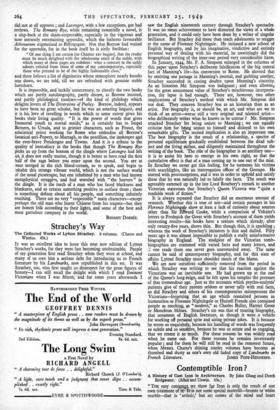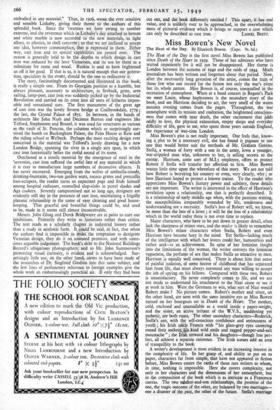Contemptible Iron ?
A History of Cast Iron in Architecture. By John Gloag and Derek Bridgwater.- (Allen and Unwin. 63s.) "THE easy contetma. we show fpr Iron is only the result of our own treatment of not some special material—bronze or white marble—that is 'artistic,' but art comes of the mind and heart embodied in any material." Thus, in 1926, wrote the ever sensitive and sensible Lethaby, giving their theme to the authors of this splendid book. Since the 'twenties we have swung to another extreme, and the reverence which in Lethaby's day attached to, bronze and white marble is now accorded to the new materials, to light alloys, to plastics, to shell concrete; so 'that we are inclined to accept any idea, however commonplace, that is expressed in them. Either way, cast. iron and its special capabilities-are passed over. The reason is generally held to be the .depths to which design in cast iron was reduced by the later Victorians, and its use by them as a substitute for stone and wood. Ruskin is said to have frightened us off it for good. If that is so, it is natural• enough that our genera- tion, specialists in the ersatz, should be the one-to rediscover it The story, fascinatingly documented .and illuStrated in this book, is really a simple one. From its Georgian position as a humble, but always pleasant, accessory to architecture, as fireback, grate, area railing, lamp-post, east iron was suddenly picked Up by the Industrial Revolution and carried on its crest into all sorts of hitherto impos- sible and sensational uses. The first monument of the great age of cast iron was the lovely Severn bridge at Coalbrookdale, 1779 - the last, the Crystal Palace of 1851. In between, in the hands of architects like John Nash and Decimus Burton and engineers like Telford, Stephenson and Brunel, it was used for structures as various as the vault Of St. Pancras, the columns which so surprisingly sur- vived the bomb on Buckingham Palace, the Palm House at Kew and the riding school at Welbeck. Perhaps the most exciting design ever conceived in the material was Telford's lovely drawing for a new London- Bridge, spanning the river in a single airy span, in which cast iron fantastically belies the stolid sound of its name. •
Outclassed as a tensile material by the emergence of steel in the 'seventies, cast iron suffered the awful fate. of any material in which it is easy to manufacture large numbers of decorative objects. It has never recovered. Emerging from the welter of umbrella-stands, drinking-fountains,"two-ton garden seats, rococo grates and portcullis foot-scrapers, the reader turns an expectant page and finds himself among hospital radiators, enamelled slop-sinks in pastel shades and Aga cookers. Severely compromised not so long ago, designers are evidently still shy in the presence of cast iron, maintaining a frigidly platonic relationship in the name of easy cleaning and good house- keeping. That graceful and beautiful things could be, and used to be, made in it seems still almost inconceivable.
Messrs. John Gloag and Derek Bridgwater are at pains to cure our inhibitions. Primarily they write as historians rather than critics. The text reads as a scholarly chapter in industrial history rather than a study in aesthetic form. It could be sard, in fact, that when the authors find it, impostible to resist the temptation to denigrate Victorian design, they, do it on unstated premises, and with some- times arguable judgement. The- book"s debt to the National Buildings Record's ubiquitous photographers, and to Mr. John Summerson's pioneering visual curiosity, is evident and is acknowledged. Sur- prisingly little use, on the other handy seems to have been made of the researches of -Dr. Siegfried Giedion into this same subject, and the few lines of perfunctory reference to foreign examples give the whole work an embarrassingly parochial air.' If only they had been
cut out, and the book differently entitled I This apart, it has real value, and is unlikely ever to be approached, in the overwhelming mass of pictorial evidence which it brings to support a case which



































 Previous page
Previous page